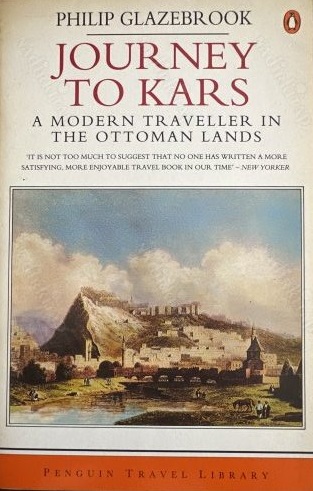FEATURE ARTICLE -
Issue 101: September 2025, Reviews and the Arts
Author: Philip GlazebrookPublisher: Penguin Travel LibraryReviewer: Stephen Keim
I relocated Journey to Kars (“Journey”) on my bookshelves, a few days before Christmas. My memory suggests that I purchased it at a second hand book store, sometime in 2012, when my interest in travel writing was strong. I believed it to be a classic of modern travel writing and was determined to read it. It seems that life intervened and Journey was left unattended and unloved on my shelves.
Philip Glazebrook was born in 1937 and died in 2007. Glazebrook wrote at least four novels: Try Pleasure (1968), The Eye of the Beholder (1974), The Burr Wood (1976) and, according to the blurb of my Penguin Travel Library edition of Journey, Byzantine Honeymoon (1979). In Glazebrook’s obituary in Encyclopedia.com, Glazebrook’s travel writings in addition to Journey (which was first published by Viking in 1984) , include Journey to Khiva: A Writer’s Search for Central Asia (1994), The Electric Rock Garden (2001), set near the India-Pakistan border in the 1970s, and, somewhat surprisingly, Byzantine Honeymoon: A Tale of the Bosphorus (1979).
It suggests a certain talent and versatility for a writer to be able to write books which some people conceive of as a novel and others conceive of as a travel book. Glazebrook references Byzantine Honeymoon in Journey. Glazebrook’s return journey from Kars takes him through Istanbul and he records how his first trip to Istanbul, the basis for Byzantine Honeymoon, started poorly with Glazebrook so unenamoured of the city that he and his companion considered returning early. The passage is part of the key analysis that emerges in Journey of both travel and travel writing in which Glazebrook states that the impressions that we have formed that drive the traveller to visit a particular place seldom mesh with the reality experienced by the traveller. The magic of travel is often found in unexpected sights and experiences quite different from that which was so deliciously anticipated. Such knowledge can guide the traveller as to how to conduct themselves in the place so as to give the magic the best chance of revealing itself.
This is an important insight from which we can all benefit. It does not, however, assist in knowing whether Byzantine Honeymoon was intended by its author to be displayed in the fiction or travel sections of bookshops.
The blurb also describes Glazebrook as intrigued by nineteenth century accounts of adventurous journeys through the Ottoman Empire and, as a result, fascinated by the heroic characters which travellers developed for themselves in their writings. This fascination expresses itself, not only by multiple discussions of the many ways in which travel writers project themselves as heroes throughout Journey, but, also, by making specific mention of the way in which a particular writer described their experiences in the very place at which Glazebrook had arrived in his narrative.
The discussion is pursued at some depth. In his bibliography, Glazebrook lists some 54 different travel writers and their works published between 1829 and 1902. Most of the travels in these were focussed on Turkey and the Levant. All of the writers in the list are discussed at some point in Journey.
There is merit in the thesis. Other people’s lives are generally of little interest to us. The same is true of other people’s holidays and trips abroad. Some of us are old enough to remember being bored almost to death by our friends’ never ending slide shows. Even now, being regaled by a colleague with their latest adventures at Queenstown or Aspen tests my pain tolerance levels. So, a travel writer must make the uninteresting story of British Airways losing one’s suitcases into something much more interesting and a tried and tested way of doing that is to cast the writer/traveller as a hero in a world out to get them.
Kars, the focus of Journey as well as Glazebrook’s trip, lay on Turkey’s eastern frontier with what then was still the Soviet Union. In that sense, it represented farawayness but, also, a sense of a real frontier. Kars is also famous for being a city within sight of Mt Ararat, the famous resting place of Noah’s cruise ship. Kars also permitted a journey from one side of Turkey to the other across Anatolia. Notwithstanding that, by 1980, Turkey had been a member of NATO and, thereby, the American and Western Empires for nearly thirty years, Glazebrook’s sense of heroism was that he was travelling through the former empire of the Ottomans which his Victorian role models had regarded as the dark country to which no person, apart from their intrepid selves, dared to venture.
Glazebrook did his best to recreate at least some of the rigours and uncertainties of earlier times. He spoke almost no words of Turkish and did not book either accommodation or transport ahead of time. In the same way as the May 2022 Brisbane flood assisted Simon Cleary in stimulating our interest in his journey down the Brisbane River, Turkey did its best for Glazebrook by hosting some kind of rebellion and declaring martial law.
Notwithstanding that Glazebrook lived and did his writing in Dorset, Journey commences in Belgrade, then the capital of Yugoslavia. In keeping with the theme of Journey, the view from the Serbian fortress of the confluence of the Danube and the Sava displayed the frontier between Christendom and Islam, between Austrian Semlin (now Zemun, a suburb of Belgrade) and Belgrade, itself, which was under Turkish suzerainty. This is where Glazebrook’s Victorians commenced their real journeys, in the words of James Fraser who made the crossing in 1836, “quitting the living for the dead” and imagining oneself to be crossing the River Styx in the company of Charon.
Glazebrook travelled by train from Belgrade to Athens and by boat to Rhodes where he stayed in the house of a friend. His crossing of the River Styx involved a private boat passage to Marmaris which is now marketed to tourists as part of the Turquoise Coast or Turkish Riviera.
Glazebrook’s account of his journey across Turkey is interesting mainly because he brings to us the lives of ordinary Turkish people despite his inability to communicate with such locals at any depth. Glazebrook does encounter soldiers and weapons most particularly in Urgup in Cappadocia where he was forced to sit and wait for a whole day. But those military who he personally encountered had little interest him as a foreigner since it was rebellious locals for whom they were looking and in whom they had interest. Enduring buses crowded with locals and local taxi like transport which was even more crowded constituted the main challenges to Glazebrook’s wellbeing.
Glazebrook did spend some time with “a handsome if melancholy Turk”, Monsieur Mestan, who spoke fluent French so that Glazebrook and M. Mestan had no trouble communicating. The trauma revealed by Mestan who ran a business providing accommodation, was that local villagers, including Mestan, himself, had used ancient building components as raw materials for their own houses but had been forced to cease such plundering by the local Antiquities Department. Hardly the Dark Ottomans that gripped the imaginations of those Victorian self-made heroes. Glazebrook spent considerable time at Mestan’s establishment for want of a bus to take him on his way. Mestan also managed, with the help of another local, to sell coins and other artefacts to Glazebrook which, despite Glazebrook’s best intentions not to get scammed, turned out to be fakes.
Glazebrook made it to Kars and, among other things, visited the Russian quarter, a leftover of military operations after the Crimean War.
Glazebrook, through much of the book, points out the British imperial and anti-non-European prejudices of the Victorian writers. At times, however, he seems to share some of those prejudices, himself. An incident with a bank manager in Trabzon, in which Glazebrook won the day and was vindicated showed, perhaps, a little more of his personality than his reflections on the shortcomings of other people did.
Before long, however, he was on his way home. A bus to Erzurum allowed Glazebrook to catch another bus through the high mountains to Trabzon, an ancient port city on the Black Sea. And, from Trabzon by boat to Istanbul before heading to Bucharest and Budapest by train. This was before the collapse of the Soviet Union and both these eastern European capitals remained under communist rule. When he got to Basle in Switzerland, he felt his journey was over.
I found Glazebrook’s writing and the travellers’ tales he told about his return journey the most interesting part of Journey. Perhaps, once the burden of travelling through darkest post-Ottoman country had been achieved, he relaxed and his natural joy of travelling came to the fore.
I found Journey an extremely interesting read. I suspect it provided interest to me that was different to that which might have been obtained from a more contemporary reading. I was, perhaps, less interested in the musings of the Victorian travel writers and their experiences than if I had read it in 1984. On the other hand, Journey offers an insight into travel of fifty years ago when there were places in the world where tourists were not a cliché.



